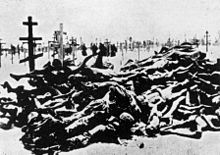1921–22 famine in Tatarstan
| 1921–22 famine in Tatarstan | |
|---|---|

Victims of the famine in Buzuluk, 1921
|
|
| Country | Soviet Union |
| Location | Tatar ASSR |
| Period | 1921–1922 |
| Total deaths | 500,000–2,000,000 |
| Observations | Failures of collectivization |
| Relief | Aid provided by the Tatpomgol, Workers International Relief, and American Relief Administration |
| Impact on demographics | 10% of the Tatar ASSR population died while another 13% fled to other parts of the country |
| Preceded by | Russian famine of 1891–92 |
| Succeeded by | Soviet famine of 1932–33 |
The 1921–1922 famine in Tatarstan was a period of mass starvation and drought that took place in the Tatar ASSR as a result of war communism policy, in which 500,000 to 2,000,000 peasants died. The event was part of the greater Russian famine of 1921–22 that affected other parts of the USSR, in which up 5,000,000 people died in total. According to Roman Serbyn, a professor of Russian and East European history, the Tatarstan famine was the first man-made famine in the Soviet Union and systematically targeted ethnic minorities such as Volga Tatars and Volga Germans.
Soviet leadership had long sought to suppress Tatar nationalism in the USSR. Tatars were frequently charged with "bourgeois nationalism" and other revisionist crimes. Tatar leadership was executed or imprisoned, which many fled the USSR to Turkey for refuge. Collectivization of Tatar agriculture began in 1921. According to historian James Minahan, Crimean Tatars in particular "suffered proportionally greater population losses than any other Soviet national group during the first decades of Soviet rule." Farming methods in the Tatar ASSR were outdated, similar to most non-Russian nationalities in the Soviet Union. In addition, very few indigenous Tatar proletariat existed due to Russian imperial dominance.
In early spring of 1921, the KGB reported massive protests and riots among peasants. By 23 March, reports began to describe the developments in some kantons as a "famine" and documented peasants starving to death and committing suicide. In response to the lack of food, many peasants prevented grain trucks from leaving Tatarstan and some refused to sow their fields. The famine also saw a large rise in the amount of children submitted to orphanages, with poorer parents leaving their children in state institutions and some just abandoning them on the streets to fend for themselves. Orphanages could not keep up with demand, and the Tatar ASSR government devoted resources to expand the number of institutions available. For example, the Sviyazhsk kanton had two orphanages, which kept 64 children in July 1920. By, January 1922, this had expanded to 12 orphanages with 704 children.
...
Wikipedia
